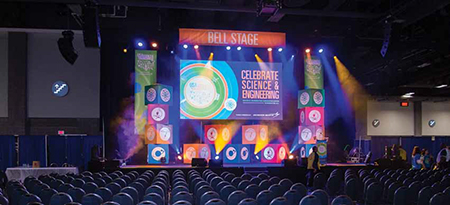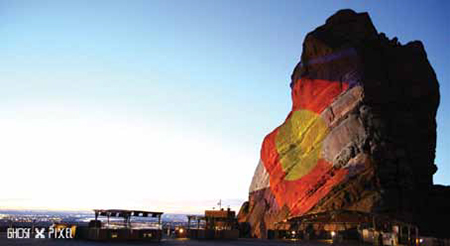Projection Mapping Moves Past its Novelty Stage

What does the luxurious Venetian Macau hotel have in common with the small, early-19th century Breda castle at the eastern edge of Hungary? Projection mapping, that’s what.
Most people have now seen, somewhere, a novel use of projection mapping, whether it be at a live event or on a shared YouTube clip, but this is just the start, said Matt Barton, director at 7thSense Design. “Projection mapping allows those with a creative mind to paint their ideas onto any surface, however large or small, and whatever the shape, with the great benefit that when they want to change it, they can do so with the click of a mouse rather than getting the paintbrushes out again. Brighter projectors, higher resolutions, and new alignment technologies are extending the possibilities of this medium all the time.”
Long regarded as an art form and attention-grabbing tool at events such as the USA Science Festival seen here, new advertising and market opportunities for projection mapping are increasingly are being explored, observed Digital Projection’s Chuck Collins. The term is often bandied about but not necessarily clearly defined, he explained. “In some cases we see the term applied simply to a projector fired onto the side of a building and some simple distortion correction and masking out of windows applied. This, with the right content, can be incredibly effective and some great shows have been produced just by doing this, but it has its limitations.”
The next level of projection mapping requires full 3D mapping where geometry data of the screen surface can be imported into the media engine, and the media distorted and mapped correction onto the 3D shape so a fully mapped canvas can be set up. “Add the recent advances in alignment calibration and we can, given the correct 3D data, have a pixel-perfect mapped projection onto the most complex of 3D objects,” he added.
The possibilities seem endless. “Projection mapping onto a 3D surface allows us to create specific content to map out the features of that surface, making it come alive. This could be done on a building, a car, or for a retail client,” said Richard Marples, strategic marketing director for entertainment at Barco.
And although mapping is certainly fashionable, it’s nowhere near its peak. “It started with a few historically significant buildings; a castle mapped to give nice colors or to highlight a musical event,” he added. “It’s been carried into new car launches, used on a life-sized model of a car without windows, all white in the perfect shape of a real car, projecting the image of wheels turning as if the car was moving and changing color.”

An Electronic Dance Music festival called “Rowdytown II” at the Red Rock amphitheater in Colorado combined several forces of nature to entertain 10,000 fans, 6,400 feet above sea level, using Barco HDQ-2K40 projectors to show an array of images with 280,000 lumens brightness. Five Barco HDQ-2K40 projectors with 1:1 lenses were used on the largest projected area, 200’ x 500’, once masked to follow the rocks, while two HDQ units covered the 150’ x 250’ area. All manner of objects are mapping candidates, even with a small projector, added Barco’s vice president of account sales, entertainment and corporate, Scott Stremple. “One of our first non-building mapping projects was projected onto New Balance tennis shoes.”
A daily selection of the top stories for AV integrators, resellers and consultants. Sign up below.
Projection mapping projects have penetrated the EMEA and Asia Pacific markets much more than North America. This leaves huge opportunities in North and South America that have barely been tapped, with much more to come, including location-based entertainment, noted Mike Garrido, senior product manager for Christie.
The artful use of mapping to entice visitors to specific locations includes projects such as the Barney’s New York 2013 window and Quartier des Spectacles in Montreal, he added. “The Montreal permanent installation is particularly important since it shows how a city has embraced the art form to add another dimension to their already rich schedule of festival and carnivals.”
And speaking of cities, once a city government requires revenue-generating permits for a project, you know that a process has reached a certain level of success, said Chuck Collins, vice president of sales and commercial AV specialist at Digital Projection. “As testament to the popularity of projection mapping, we have been told on more than one occasion a project has been delayed because a city now requires several permits for projector-mapping projects.”
Eat and Play
Projection mapping can also take a smooth surface and turn it into a 3D canvas, such as using graphic design to make a basketball court appear 3D, Stremple explained. “The Philadelphia 76ers have announced a deal to do 3D mapping of their basketball court engaging with a Barco partner, Quince Imaging. Quince will be using Barco’s HDF W-26 26,000 lumen projector in this installation.”
And where there are sports, can dining applications be far behind? The chef at the Hard Rock Hotel Ibiza has created a restaurant where everything on the table is mapped, Marples added. “Plates change colors, sounds and smells are produced; it’s a sensory overload. The entire Barco mapping onto a table is done completely in time with everything else going on around it.”
Projection mapping is becoming part of the infrastructures and destinations as a crowd draw, he offered. “By changing content regularly, seasonally, etc., you can update continually to keep it fresh and new. Venue owners have constant struggles in attracting and retaining customers’ attention in a mall or in an airport. By making the venues exciting with projection mapping, customers feel happy and relaxed and are more apt to spend.”
Requests are coming in from designers and architects who want to transform both new and existing public spaces using projection mapping technology, Stremple said. “These are on very large scale projects, most of which cannot be disclosed at this time, but include sports, theme parks, retail, and worship venues.”


At Barneys in New York City, the BNY SCC Gallery served as an art gallery for a Barneys New York and Shawn ‘JAY Z’ Carter collaboration—an immersive 1,200-square-foot space with a seamless 360-degree projection blending the images from nine Christie HD6K-M projectors to create a cinematic urbanscape. The “Floating City” window mapped images from four Christie LW650 projectors onto a 3D architectural typography of New York City that included changing geographical landscapes and climate (like snow and rain). DP also is seeing an increase in requests from its staging partners who want to discuss projection mapping projects, Collins noted. “We have participated in both indoor and outdoor projects. Even the smaller and midsized staging companies have approached us for advice and guidance.”
So far most of the mapping shows and performances people have experienced have been created on static objects. “New advances in techniques and tools will soon break this limitation,” Barton said, “allowing mapping and tracking onto moving objects which will add a whole new dimension to the world of projection mapping.”
Part of its allure is that the technology allows people to create and add to atmospheres around large events and allows for entertainment in a small space, Garrido pointed out. “As the technology advances, you will see a lot of exciting new projects and ideas. Some will be grand and others will be focused at a small niche.”
As it progresses, the technology will be more aimed at educating and maybe even entertaining in the home, with full interactivity, not only for television on any surface, but also for a page reference on a book or web page anywhere, or possibly showing the quickest evacuation route in case of emergency, he summarized.
“Interactivity is a trend we’ve started to see already such as in installing it to see the tracks where people are moving through a scanner or camera,” Marples said. “You can detect whether people are entering a particular venue, and in which direction they’re going. This can be built around gaming engines/graphics cards and content can be interactive; people want to be seen in a space.”
And expectations are high, Barton said. “Consumers have such excellent flat screen displays in their homes and offices these days that large flat screen displays in shop windows and music/sports venues just won’t cut it anymore. People want the wow factor— something they can’t see at home. Projection mapping, when done correctly, can look fantastic from many angles, does not require special glasses or an understanding of the technology, and is a captivating display that few, if any, will have the ability to recreate at home.”
And the public knows what it wants, Marples concluded. “In 2003, a small town in France started to install projection mapping at several sites. “They did it each year for several years, here and there in the town, until one year they stopped because of cost.”
There was outrage in the town because tourist numbers plummeted. “In 2013, they spent about two million Euros on a new install,” he said, “presenting mapping every night from April to October at 16 sites. So, no, we have not yet reached the saturation point.”
Karen Mitchell is a freelance writer living in Boulder, CO.
On Terra Firma
When it comes to projection mapping, it’s not a question of when. It’s a matter of how far we can take it.
Projection mapping has morphed from offering a temporary thrill to a more permanent status with installations at museums, visitor destinations, and retail locations around the globe, with no end in sight for its application possibilities.
Long regarded as an art form and attention-grabbing tool, advertising and market opportunities increasingly are being explored, said Digital Projection’s Chuck Collins. “We are working on at least one project for a commercial shopping experience in which several of our laser illuminated projectors will be installed permanently in environmental enclosures.”
The blended and warped images, he explained, will be projected on a very odd shaped screen in the evenings, year round. “The lower cost of operation of laser illumination makes this sort of project financially viable.”
Projection mapping is entering the museum and visitor attraction world, noted 7th Sense’s Matt Barton. “Sega Orbi, opened in Japan last year, uses projection mapping extensively. It’s a great concept for long-term investment since it creates adaptable exhibits that can change theme simply by switching content; one minute a pile of boxes can become a rainforest waterfall, the next an erupting volcano.”
Permanent Christie installations include Hungary’s Breda Castle, featuring its Roadster projectors, and projects at China’s Wuxi Studio and India’s Old Fort, said Christie’s Mike Garrido.
Not surprisingly, Disneyland is in the mix, with a permanent Barco projection mapping installation there at night, as well as another at the Venetian Macau hotel. “Projection mapping already is being adopted in sports arenas,” said Barco’s Scott Stremple. “We’re aware of many opportunities in corporate, house-of-worship, and retail locations.”
Even as the technology advances, he cautioned, it’s still a challenge on the content creation side as the costs can be very high. “With better software and hardware you’ll see costs come down, and find the technology applied almost anywhere somebody wants consumers to visit their venue.”
—K.M.
